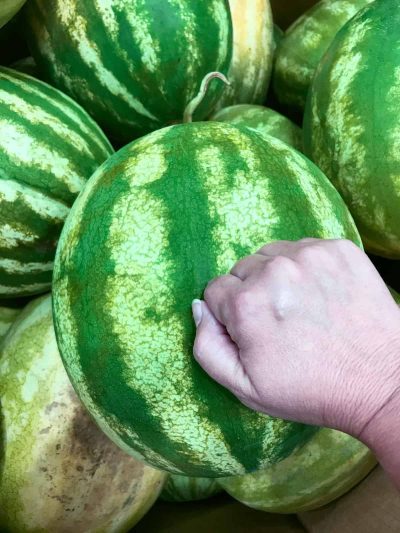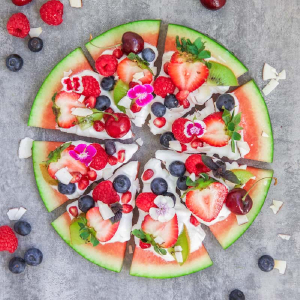The best way to test the ripeness of a watermelon is with a tap of your knuckle. Old school? Definitely. But far from a myth. And it’s approved by generations of Moms. Here’s your guide to performing the perfect ‘tap’ test…

A colourful history…
Folks have been tapping watermelons for generations. And the iconic practice has been immortalized in books and films.
My favourite instance is one of the older-couple interviews in When Harry Met Sally (1989). An off-camera inter-viewer asks the women how she knew her husband was The One. She comes right back with a big, knowing grin and says, “You just know, like a good melon…”
The technique
The ‘tap’ test is probably the best way to tell a ‘good melon’. It’s another in a family of such tactile methods used to determine the ‘doneness’ of foods.
Perhaps the most famous is the touch test for the degrees of doneness of a steak. Beef aficionados insist that the supreme steak maestros can detect whether a steak is rare, medium or well done just by palpitating it. I’ve studied how-to guides, and practiced the move dozens of times. But I still can’t rely on my touch to tell an accurate tale.
However… Since my Mom and her Mom and my Dad’s Mom all knew and successfully practiced the watermelon tap test, I feel secure in offering a brief rundown on this useful technique.
How to do it
Just tap your prospect watermelon sharply in its longitudinal middle and listen closely to the sound it makes.
If it sounds firm and echoes, it’s ready to slice. If the sound is dull and doesn’t resonate, its either unripe (too hard to echo), or overripe (to soft and flabby to echo).
Further research…
If you determine your chosen melon is ripe, you can double-check by consulting a couple of other indicators.
Once cut open, you should see uniform dark red flesh. No cracks or voids. Light coloured flesh may indicate that the melon got too much water late in its growth and ‘blew up’, diluting the flavour.
Likewise, the seeds should be dark brown. Not black, and definitely not white – except for some specific varieties.
Perfect for all occasions
The prefect, ripe watermelon will never let you down. You can use it with confidence in all applications that come to mind. And remember – there’s much more to serving watermelon than simply cutting it in drippy, slurpy wedges.
For a start, you can enhance that wedge with a whipped topping and cookie crumbs. Or dip it in chocolate! Try a Tequila-infused wedge for a summer cocktail-hour treat!
Don’t be afraid to use watermelon in place of peaches, plums or pineapple chunks in desserts.
And be sure to try watermelon in all your fave summer salads…
My take
There’s a whole undiscovered world of watermelon recipes out there, ripe for the Googling! The US Watermelon Board has a whole flock of ingenious and tasty recipes for to get you started. And a gallery of some really amazing watermelon carvings…
Go forth and tap!
~ Maggie J.

